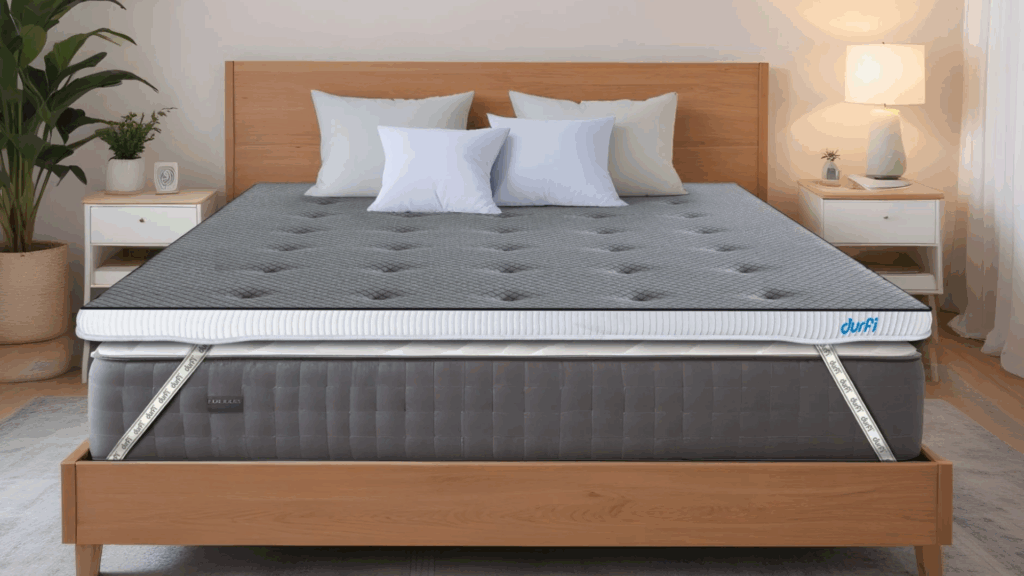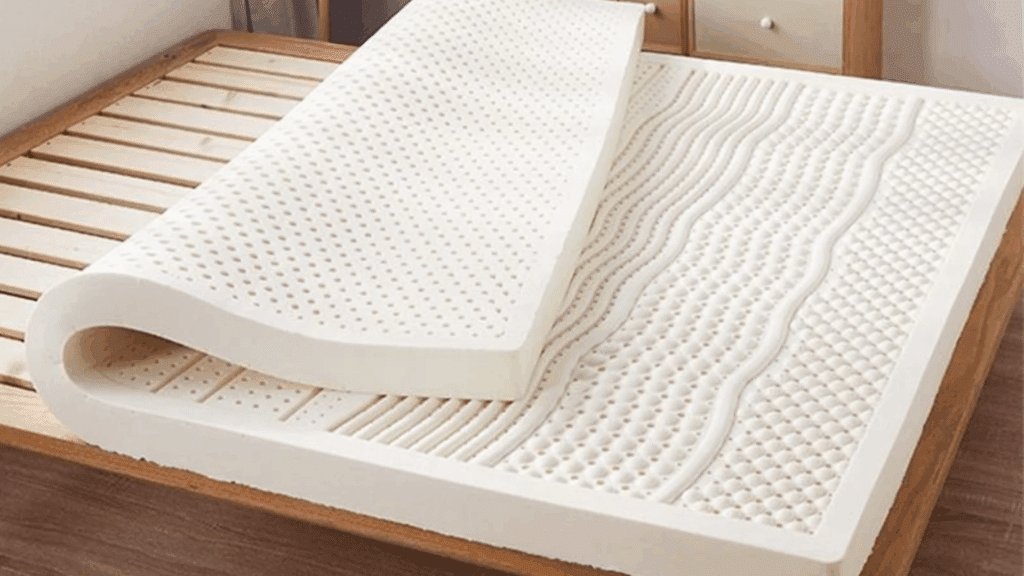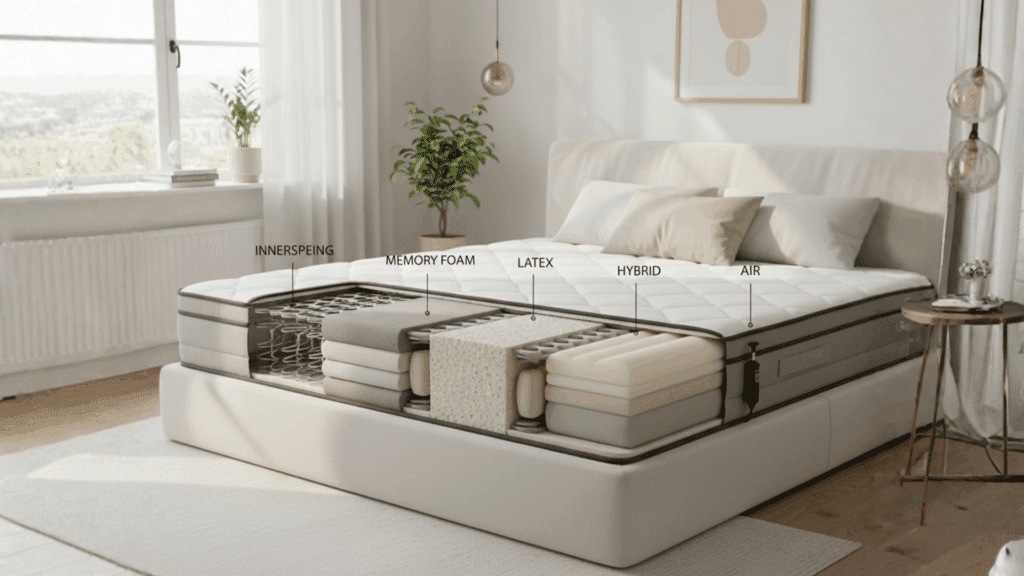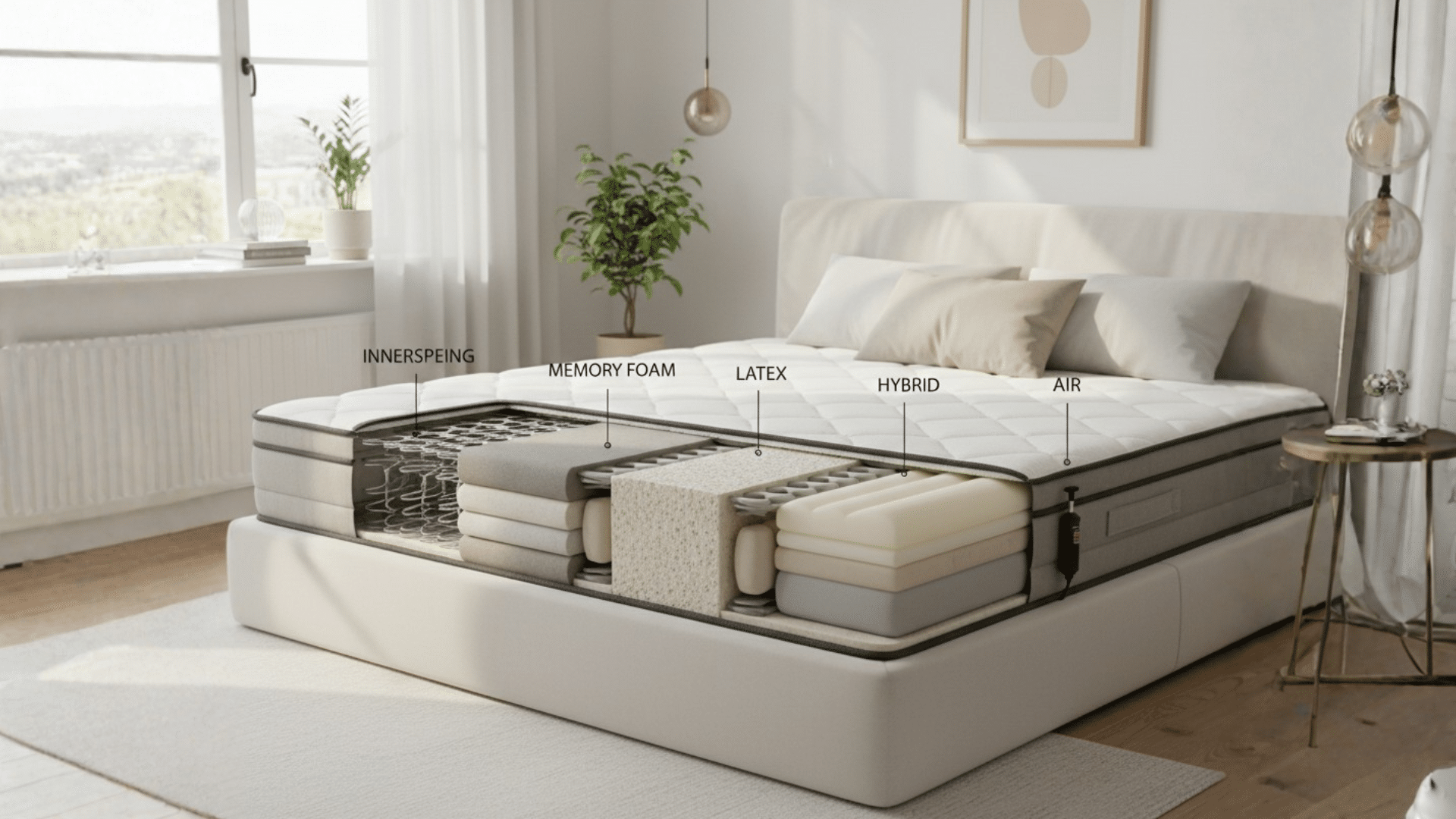When I first started shopping for a mattress, I was completely lost. Every option sounded the same until I realized each one feels and performs differently.
You’ve probably had that same moment, lying on a bed that seems fine in the store but feels wrong at home. The truth is, your comfort depends on understanding the different types of mattresses and how each supports your body.
Some keep you cool, others hug your shape, and a few balance both. Once you know the difference, it’s easier to choose what fits your sleeping habits and budget.
If you’re replacing an old bed or buying your first, finding the right type can completely change how you rest each night.
Mattress Basics: What You Should Know First
Before comparing different mattress types, it’s worth knowing what truly affects your comfort.
Every mattress has three main layers: a support base, a comfort layer, and a cover. The base provides structure and durability, while the comfort layer determines softness, bounce, and temperature control.
Materials like coils, foam, or latex influence how firm or plush the mattress feels. Airflow also plays a big role in keeping you cool through the night.
When you understand these basics, it’s easier to recognize what your body needs before choosing the style or material that best suits you.
Types of Mattresses Explained
Mattresses come in several types, each designed for different comfort needs. Here’s how the main types compare in feel, support, and durability.
1. Innerspring Mattress

Innerspring mattresses use a network of metal coils topped with a thin comfort layer.
They provide a firm, bouncy feel and promote airflow, keeping you cooler during sleep. These are great for warm climates and people who prefer a more traditional, supportive surface.
| Feature | Details |
|---|---|
| Best for | Hot sleepers and those who want firm support |
| Pros | Breathable, durable, affordable |
| Cons | Transfers motion, may sag with time |
| Average Lifespan | 6–8 years |
| Typical Price (U.S.) | $300–$1,000 |
2. Memory Foam Mattress

Memory foam mattresses are made with viscoelastic foam that contours closely to your body shape. They offer pressure relief and help align the spine, making them popular for side and back sleepers.
The foam absorbs movement well, so you won’t feel your partner toss around. However, they can trap heat unless infused with cooling gel.
| Feature | Details |
|---|---|
| Best for | Side sleepers and people with joint or back pain |
| Pros | Excellent motion isolation, deep pressure relief |
| Cons | Can retain heat, softer edges |
| Average Lifespan | 7–10 years |
| Typical Price (U.S.) | $400–$1,500 |
3. Latex Mattress

Latex mattresses are made from natural or synthetic latex foam. They feel springy yet supportive, offering gentle cushioning without the sinking sensation of memory foam.
Natural latex models are breathable and hypoallergenic, ideal for people who sleep hot or prefer organic materials. They last long but are heavier and more expensive than other options.
| Feature | Details |
|---|---|
| Best for | Hot sleepers and eco-conscious buyers |
| Pros | Long-lasting, breathable, supportive |
| Cons | Heavy, higher upfront cost |
| Average Lifespan | 10–12 years |
| Typical Price (U.S.) | $1,000–$2,500 |
4. Hybrid Mattress

Hybrid mattresses combine an innerspring base with comfort layers made of memory foam or latex.
This blend gives you both sturdy support and plush cushioning. They offer strong edge support and reduce motion transfer, making them great for couples.
Hybrids adapt to most sleep styles but can feel heavier and cost more than standard models.
| Feature | Details |
|---|---|
| Best for | Couples and combination sleepers |
| Pros | Balanced comfort, support, and cooling |
| Cons | Expensive, heavier to move |
| Average Lifespan | 8–10 years |
| Typical Price (U.S.) | $800–$2,000 |
5. Air Mattress

Air mattresses feature internal air chambers that let you adjust firmness levels using a remote or mobile control.
Each side can be customized, so couples can set their preferred comfort level. They’re excellent for flexibility but require occasional maintenance to prevent leaks.
Some higher-end models even include smart sensors for sleep tracking.
| Feature | Details |
|---|---|
| Best for | Couples with different firmness preferences |
| Pros | Adjustable firmness, easy setup, customizable |
| Cons | Prone to leaks, requires upkeep |
| Average Lifespan | 5–7 years |
| Typical Price (U.S.) | $700–$2,500 |
Niche Mattress Types
- Gel Foam Mattress: Similar to memory foam but infused with cooling gel to reduce heat buildup.
- Smart Mattress: Uses sensors to track sleep quality and automatically adjusts firmness or temperature.
- Organic Mattress: Made from natural materials like latex, wool, and cotton, free from synthetic chemicals.
- Sofa Bed and Camping Mattress: Compact and portable, ideal for guests or outdoor use.
- Mattress Topper: Adds comfort or firmness without replacing your full mattress.
Buying Guide: How to Choose the Right Mattress
Step 1: Measure your room and consider who sleeps on the bed. Match sizes to space and users: twin for kids, full for teens, queen for couples, king for large rooms too.
Step 2: Think about how you like a bed to feel. Soft cushions shoulders and hips, medium balances comfort and support, firm keeps your body lifted and works better for stomach sleepers.
Step 3: Compare core materials and covers. Look for breathability, bounce, edge support, and motion control. If sustainability matters, consider natural latex, cotton covers, recycled foams, and trusted safety certifications, labels, too.
Step 4: Try mattresses in-store for ten minutes per position, focusing on pressure points and spinal alignment. Shopping online? Use sleep trials, easy returns, and reviews from verified buyers to guide choice.
Step 5: Read the warranty terms and return policy before buying. Note trial length, pickup fees, sagging coverage, repair terms, and claim process. Favor clear coverage with simple steps and responsive support.
Maintenance and Mattress Care
Proper care keeps your mattress clean, supportive, and comfortable for years. Follow these simple habits to protect your investment.
- Rotate Regularly: Turn your mattress every three to six months to prevent uneven wear and sagging in pressure areas.
- Use a Protector: A waterproof, washable cover shields against spills, sweat, and dust, keeping your mattress fresh longer.
- Vacuum Often: Clean the surface gently with a handheld vacuum to remove dust, allergens, and debris that collect over time.
- Spot Clean Immediately: Treat stains right away using mild soap and water. Avoid harsh chemicals that damage fabric or foam layers.
- Keep It Dry: Allow airflow around your mattress by lifting it occasionally and avoiding direct moisture or damp spaces.
- Avoid Sitting on Edges: Repeated edge pressure weakens support and shortens comfort life; sit or rest in the center instead.
Eco-Friendly and Sustainable Mattresses
Eco-friendly mattresses are designed to give you comfort while reducing environmental impact. These beds use materials and production methods that are safer for you and the planet.
Many feature organic latex, bamboo fabric, cotton covers, or recycled foam, which are naturally breathable and free from harmful chemicals.
Look for trusted certifications like CertiPUR-US, OEKO-TEX, and GOTS, which ensure the materials meet safety and sustainability standards.
When it’s time to replace your mattress, avoid landfills, donate or recycle it through local programs or manufacturers that offer pickup and recycling services for old bedding.
Conclusion
Now that you know how each mattress type works, finding your perfect match should feel much easier.
Every option under the types of mattresses category offers something unique, from the firm support of coils to the contouring comfort of foam or the bounce of latex.
The right choice depends on what helps you relax, stay cool, and wake up refreshed. I’ve learned that good sleep isn’t about trends or price; it’s about balance and fit.
So, take what you’ve read here, think about your body and habits, and choose the one that feels right. What kind of mattress do you trust for a good night’s sleep? Share your pick or check more sleep guides next.









